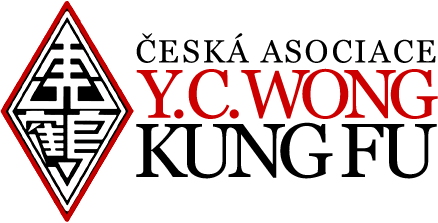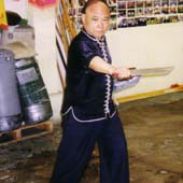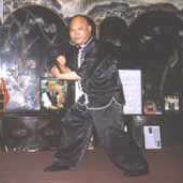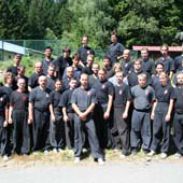The modern Hungga of Y.C. Wong
Inside Kung-Fu, February 1981.
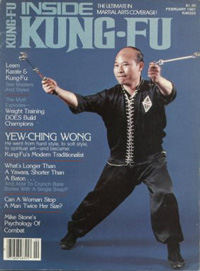 BOOM! The earth shook. BOOM! BOOM! Jisin Simsi sat up in his bed. Smoke blurred his vision. BOOM! Jisin ran to the nearest window. BOOM! Outside, the temple was under seige. Imperial troops attacked with explosives, muskets, spears, swords, and knives. And although an occasional Siulam monk fought back heroically, they were too surprised and too outnumbered. One by one, they fell. BOOM! On impulse, Jisin spun around just as a troopers spear missed his kidneys. He sidestepped another thrust from a second trooper. Then, in a whirlpool of motion, he grabbed the spear and flung the second trooper into the first. By the time the two soldiers had regained their footing, Jisin was out the door and across the temple's courtyard. Other troopers began to pursue him. But he dove forward into a roll, landing inside the cover of shrubs and bushes. Jisin knew there was a hidden passageway nearby. Frantically, he searched the ground and dug with his hands until he had unearthed the entrance. The passageway led underneath the temple, through the mountain, and out the other side. Several other monks also had managed to escape the holocaust to find their way through the mountain in still other tunnels.
BOOM! The earth shook. BOOM! BOOM! Jisin Simsi sat up in his bed. Smoke blurred his vision. BOOM! Jisin ran to the nearest window. BOOM! Outside, the temple was under seige. Imperial troops attacked with explosives, muskets, spears, swords, and knives. And although an occasional Siulam monk fought back heroically, they were too surprised and too outnumbered. One by one, they fell. BOOM! On impulse, Jisin spun around just as a troopers spear missed his kidneys. He sidestepped another thrust from a second trooper. Then, in a whirlpool of motion, he grabbed the spear and flung the second trooper into the first. By the time the two soldiers had regained their footing, Jisin was out the door and across the temple's courtyard. Other troopers began to pursue him. But he dove forward into a roll, landing inside the cover of shrubs and bushes. Jisin knew there was a hidden passageway nearby. Frantically, he searched the ground and dug with his hands until he had unearthed the entrance. The passageway led underneath the temple, through the mountain, and out the other side. Several other monks also had managed to escape the holocaust to find their way through the mountain in still other tunnels.
Immediately on the other side, the monks began to run. Sometimes together. Sometimes alone. They knew that Imperial troopers would soon follow. Finally, at the harbor of Sawan, the monks were forced to stand and fight And although greatly out numbered, the monks managed to fight oft the pursuing Imperial force... but at a great price. Out of eighteen monks, only Gee-sin and four others survived the battle. Or, at least so the legend goes. Jisin simsi is supposedly the founder of the Hungga system of gungfu. In truth, he is probably a fictional character. But since Hungga ranks with Taijiquan as the most influential Chinese fighting art-indeed, Hungga is believed to be the direct Chinese ancestor of Okinawan karate - the Jisin legend holds significance for most modern martial artists. According to the story, the five surviving monks vowed to avenge the deaths of their comrades by leading China in open revolution against the Ching dynasty. They agreed to form a secret society to prepare for the rebellion, and then each dispersed to find more recruits. All members of the society were to be considered brothers under the family name of hung, which means "red," and was the name of the ruling household during the Ming dynasty. Jisin simsi fled southward into Canton where he found refuge inside Canton's opera houses. Chinese opera made extensive use of the martial arts and was, therefore, an excellent ruse for a rebellious Siulam monk. He began to teach Siulam gungfu to other militant patriots.
The opera troupes in those days traveled down the Pearl River delta on boats. These boats were called hung chyun, or "red boats" in reference to the red pants worn by the boatmen. Much of Jisin simsi's instruction was aboard these boats between performances. Jisin was forced to adapt his Siulam system to less-than-favorable conditions. The boats were unstable and perpetually rocked back and forth. Thus Jisin taught his students to fight in very low very strong horse stances. Also, there was not a lot of room on board, so the monk de-emphasized kicking and jumping techniques. Soon, Jisin simsi sent his students out on their own to organize other patriots and teach them gungfu. And since the river boats upon which that art developed were called hung chyun, the name of the rebel's fighting art quickly became known as Hungga. Unfortunately, their numbers did not grow large enough soon enough to lead the revolution they dreamed about. Today, because the early practitioners were confined by tight spaces, Hungga is based on the concept of an immovable foundation. That is the Hungga practitioner prefers to stand in place, using the low horse stance to remain as immovable as a boulder. Then the opponents attacks will bounce painfully and sometimes injuriously off the Hungga blocking and guarding actions, and create openings for counterattack. At this point, the Hungga stylist can end the struggle with one powerful blow which rips muscles, breaks bones, dislocates joints, or worse... kills. Clearly, Hungga was intended to be the artistic expression of power, but at the expense of speed. It is with this inherent preference of the system that San Francisco's Y.C. Wong, one of the country's foremost Hungga instructors, takes exception. "Hungga is a Southern style," explains Wong. "And Southern styles have a lot of power and rely on the stability of the horse stance to enhance that power. But I feel that a combination of speed and power is better balanced and represents, at least to me, a better art." Wong still recalls the early days of his gungfu career when, as a child in Gwongdung Province, China, he was expected to study just one style from just one instructor.., whether or not that style or instructor offered him what he needed in an art. To learn a second art or to question the instructors teaching was considered disrespectful and unforgivable. "People today are not as conservative as they used to be when a man learned only one system and stuck to it The practitioner of today wants to expand into other systems, to increase his art. You see, gungfu is like knowledge. Obviously, the more you learn, the more knowledge you have. And every system adds something to your knowledge." So when Y.C. Wong immigrated to the U.S. in 1963, he immediately began to look at other styles of gungfu. Traditionally, gungfu systems are divided into two camps: the hard systems and the soft systems. This division reflects the influence of the Taoist theory of changes from classical Chinese philosophy. Soft styles rely primarily on indirect leverage to turn the opponents strength against himself. They are characterized by indirect tactics and speed techniques. Of course, since Wong comes from a hard style, the first art he chose to study had to be a soft style. He chose Taijiquan, the grandfather of all soft styles, as well as Taijiquan's sister arts of Bagua and Xingyi. Taijiquan was originally developed as the Taoists' answer to Shaolin. The art grew out of the Taoist search for immortality. Taoists believed that dance-like exercise could maintain the harmonious balance between yin and yang within the body-and so increase the circulation of life-sustaining qi or inner strength.
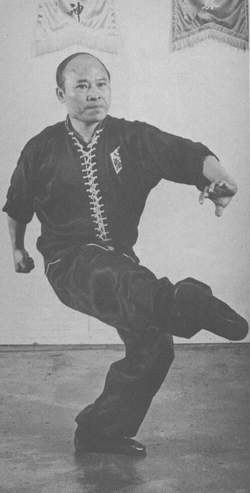 Each dance-like posture of Taijiquan was designed to be the physical embodiment of some element of Chinese philosophy. For example, when your weight is over the rear leg, you are yin. And when your weight is over the lead leg, you are yang. As the opponent attacks, you become yin, pulling him off balance. But as he attempts to retreat, you become yang and uproot him. Yin and yang are kept in constant balance. In contrast, Bagua and Xingyi are further elaborations on the Taijiquan ideal. Bagua techniques key off of '"walking the circle," or circling around your opponent in preparation for a counterattack. Bagua stresses the use of horizontal, circular movements and the open palm. Frequently, a Bagua practitioner in action will resemble a cross between a judoka and an aikidoka since many Bagua counterattacks employ graceful throws. But Xingyi is based on solid footholds. Movement is largely linear, expounding the strength of the straight line. Xingyi stresses the use of vertical power and the clenched fist Taijiquan, Bagua and Xingyi are internal systems, which are a special category of soft style. They rely on leverage to turn the opponents inner strength against himself. This type of counterattack is accomplished by patiently setting the opponent up for a devastating close-range attack which catches him both mentally and physically off-balance. Since the attack coincides with the opponents moment of absolute helplessness, internal practitioners can frequently defeat an opponent without hurting him. Internal systems always embody some element of Chinese philosophy. Taijiquan is the yin and yang of boxing. Bagua is the eight trigrams boxing. And Xingyi is the five elements boxing. After Wong was exposed to the soft styles, he began to modify his own Hungga system, to soften it up and round it out a bit He made it more agile and smooth. Not that he thought there were any combat contingencies for which the classical system was inadequate, but rather that his changes did not affect the art's practical utility. Indeed , he believed that his changes would strengthen, expand and improve the art-or, as Wong says, "Just because you learn how to swim, that doesn't mean you lose the ability to walk". Still, Wong continues to preserve the five classical forms of Hungga. The first, called gungji fuk fu, is reputed to have been composed by Jisin Simsi, personally, for practice on the river boats. The other four forms are recognizable as basic Southern Shaolin, with special emphasis on the horse stance.
Each dance-like posture of Taijiquan was designed to be the physical embodiment of some element of Chinese philosophy. For example, when your weight is over the rear leg, you are yin. And when your weight is over the lead leg, you are yang. As the opponent attacks, you become yin, pulling him off balance. But as he attempts to retreat, you become yang and uproot him. Yin and yang are kept in constant balance. In contrast, Bagua and Xingyi are further elaborations on the Taijiquan ideal. Bagua techniques key off of '"walking the circle," or circling around your opponent in preparation for a counterattack. Bagua stresses the use of horizontal, circular movements and the open palm. Frequently, a Bagua practitioner in action will resemble a cross between a judoka and an aikidoka since many Bagua counterattacks employ graceful throws. But Xingyi is based on solid footholds. Movement is largely linear, expounding the strength of the straight line. Xingyi stresses the use of vertical power and the clenched fist Taijiquan, Bagua and Xingyi are internal systems, which are a special category of soft style. They rely on leverage to turn the opponents inner strength against himself. This type of counterattack is accomplished by patiently setting the opponent up for a devastating close-range attack which catches him both mentally and physically off-balance. Since the attack coincides with the opponents moment of absolute helplessness, internal practitioners can frequently defeat an opponent without hurting him. Internal systems always embody some element of Chinese philosophy. Taijiquan is the yin and yang of boxing. Bagua is the eight trigrams boxing. And Xingyi is the five elements boxing. After Wong was exposed to the soft styles, he began to modify his own Hungga system, to soften it up and round it out a bit He made it more agile and smooth. Not that he thought there were any combat contingencies for which the classical system was inadequate, but rather that his changes did not affect the art's practical utility. Indeed , he believed that his changes would strengthen, expand and improve the art-or, as Wong says, "Just because you learn how to swim, that doesn't mean you lose the ability to walk". Still, Wong continues to preserve the five classical forms of Hungga. The first, called gungji fuk fu, is reputed to have been composed by Jisin Simsi, personally, for practice on the river boats. The other four forms are recognizable as basic Southern Shaolin, with special emphasis on the horse stance.
However, the most famous of the Hungga routines is the fu hok kyun, or tiger crane form. Once a very secretive form, the combination of the two animals was the inspiration of a woman who chanced to see a tiger and white crane in battle. But no further significance is assigned to the animals. Wong admits, though, that he has made the form movements a bit less explosive, but more fluid. "I'm at middle age now. I'm not looking for anything that external. Instead, I'm looking for constant health and relaxation. I want something that will preserve my body into old age. "I've noticed that a lot of hard training is bad for the heart. And, also, overtraining can shorten your life. It makes you use' up your vitality. But the internal systems, based on Taoism, teach self-healing and Chinese medicine. You learn about the radiance and the flow of energy. That's why I've included internal training with my Hungga." Most recently, Y.C. Wong expanded his teachings even further to include meditation and philosophy. "When I began taking meditation," explains Wong, "I immediately noticed that something had been missing from my own training. For example, most of the time when you practice gungfu, your mind is functioning at a competitive level. You train yourself to develop sufficient speed, power and technique so that you can either defeat all of your opponents, or so that you have at least shown improvement over your previous self. In other words, you're always looking for some kind of reward. "But the problem with the reward approach is that you'll never find it. Its a never-ending search. But after you start meditating, you notice that you feel content and peaceful inside yourself. There's no more chasing after things outside yourself. No more comparing yourself to others, or even to yourself. You just feel good inside. You feel in harmony. And that's when you start to feel the flow of your own energy, of your potential for power. "And then, you know what? Your physical techniques become stronger, faster, more powerful, but by putting out less energy." And so, that's the modern Hungga of Y.C. Wong. With regard to other styles, he believes there is no one superior system. All styles have their strong points. What matters to him is the willingness to learn and train. And perhaps the greatest benefit of training is the artistic unity of the mind and body.
